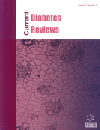- Home
- A-Z Publications
- Current Diabetes Reviews
- Previous Issues
- Volume 8, Issue 4, 2012
Current Diabetes Reviews - Volume 8, Issue 4, 2012
Volume 8, Issue 4, 2012
-
-
Anti-Vascular Endothelial Growth Factor Drug Treatment of Diabetic Macular Edema: The Evolution Continues
More LessDiabetic mellitus is the leading cause of blindness in working aged patients in developing nations. Due to the buildup of abnormal metabolites from several overactive biochemical pathways, chronic hyperglycemia causes oxidative stress in the retina which upregulates vascular endothelial growth factor (VEGF). Together with other growth factors and metabolites, VEGF causes endothelial cell proliferation, vasodilation, recrui Read More
-
-
-
The Management of Gestational Diabetes
More LessAuthors: Caroline Ovadia and Archana DixitThe incidence of gestational diabetes is increasing, with higher obesity in the pregnant population, lifestyle changes and migration thought to underlie this. Recent large studies, such as the MiG, HAPO and ACHOIS trials, have furthered our understanding of both the implications of the disease and the management options available. Previous CEMACH (Confidential Enquiries into Maternal and Child Health) studies of diab Read More
-
-
-
Pharmacotherapy in Type 2 Diabetes: A Functional Schema for Drug Classification
More LessWith growing awareness that long-term hyperglycemia is directly implicated in the tissue damage characteristic of diabetes, there has been a corresponding increase in clinicians’ willingness to employ intensive treatment to achieve euglycemia, which may require diabetes drugs in combination. The expanding array of drugs with different mechanisms of action calls for a clear method of classification to guide rationa Read More
-
-
-
Insulin Resistance in the Early Stages of Renal Failure: Implications for Cardiovascular Risk
More LessAuthors: Catena Cristiana, GianLuca Colussi, Stefania Fedrizzi and Leonardo A. SechiAn elevated risk of cardiovascular events is present in patients with mild-to-moderate renal function impairment. Similar to patients with end-stage renal disease, this elevated risk can be accounted for by high prevalence of classic and emergent cardiovascular risk factors and additional conditions that are more specifically related to the organ failure, such as anemia and electrolyte disturbances. Among emergent cardio Read More
-
-
-
Subthreshold Diode Micropulse Laser Photocoagulation (SDM) as Invisible Retinal Phototherapy for Diabetic Macular Edema: A Review
More LessAuthors: Jeffrey K. Luttrull and Giorgio DorinPurpose: To present the state-of-the-art of subthreshold diode laser micropulse photocoagulation (SDM) as invisible retinal phototherapy for diabetic macular edema (DME). Method: To review the role and evolution of retinal laser treatment for DME. Results: Thermal laser retinal photocoagulation has been the cornerstone of treatment for diabetic macular edema for over four decades. Throughout, laser induced retinal damage pr Read More
-
-
-
FGF21: The Center of a Transcriptional Nexus in Metabolic Regulation
More LessAuthors: A. C. Adams and A. KharitonenkovFibroblast growth factor 21 (FGF21) is emerging as a key regulator of energy homeostasis and presents a novel target for the development of therapies for the treatment of diabetes, cardiovascular disease and obesity. Recent publications have demonstrated that FGF21 resides downstream of a complex network of transcriptional regulators which modulate its expression in response to a wide array of physiologic Read More
-
-
-
Corneal Changes in Diabetes Mellitus
More LessAuthors: Guzel Bikbova, Toshiyuki Oshitari, Ayako Tawada and Shuichi YamamotoDiabetes mellitus is a major disease worldwide, and the prevalence of diabetes has risen significantly in the past several decades. Although one of the major complications of diabetic eyes is diabetic retinopathy (DR), corneal diseases can not only develop in diabetic patients but are also difficult to manage. Diabetic neurotrophic keratopathy is a component of diabetic polyneuropathy and is recognized to be the cause of the morb Read More
-
-
-
The Good and Bad Effects of Cysteine S-nitrosylation and Tyrosine Nitration upon Insulin Exocytosis: A Balancing Act
More LessAuthors: Dean A. Wiseman and Debbie C. ThurmondAs understanding of the mechanisms driving and regulating insulin secretion from pancreatic beta cells grows, there is increasing and compelling evidence that nitric oxide (•NO) and other closely-related reactive nitrogen species (RNS) play important roles in this exocytic process. •NO and associated RNS, in particular peroxynitrite, possess the capability to effect signals across both intracellular and extracellular compartme Read More
-
Volumes & issues
-
Volume 21 (2025)
-
Volume 20 (2024)
-
Volume 19 (2023)
-
Volume 18 (2022)
-
Volume 17 (2021)
-
Volume 16 (2020)
-
Volume 15 (2019)
-
Volume 14 (2018)
-
Volume 13 (2017)
-
Volume 12 (2016)
-
Volume 11 (2015)
-
Volume 10 (2014)
-
Volume 9 (2013)
-
Volume 8 (2012)
-
Volume 7 (2011)
-
Volume 6 (2010)
-
Volume 5 (2009)
-
Volume 4 (2008)
-
Volume 3 (2007)
-
Volume 2 (2006)
-
Volume 1 (2005)
Most Read This Month
Article
content/journals/cdr
Journal
10
5
false
en


